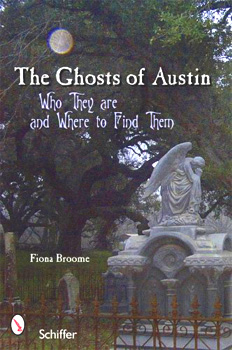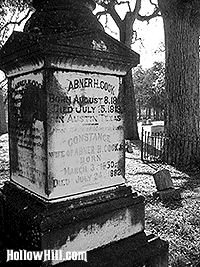As an Amazon Associate I earn from qualifying purchases. Click for details.
Austin, Texas has many ghosts. While researching Austin for my 2007 book, The Ghosts of Austin, Texas, I found patterns to many of the hauntings. Here’s one of them.
The Shoal Creek Curse
 O. Henry, the famous author and former resident of Austin, once wrote, “It is a well-known tradition in Austin and vicinity that there is a buried treasure of great value on the banks of Shoal Creek, about a mile west of the city…”
O. Henry, the famous author and former resident of Austin, once wrote, “It is a well-known tradition in Austin and vicinity that there is a buried treasure of great value on the banks of Shoal Creek, about a mile west of the city…”
Two treasures were buried at Shoal Creek. One is from 1770 and the other is from 1836. One may have been found; the other wasn’t.
Searching for those treasures resulted in many deaths and hauntings. But, gold isn’t all that’s buried at Shoal Creek, and treasure hunters aren’t its only ghosts.
Gideon White was killed with several others during the 1842 massacre at Shoal Creek. No one is certain how many of the victims were buried at the site. (White’s grave at nearby Oakwood Cemetery is also haunted.)
There are many other unmarked graves at Shoal Creek. Many victims of cholera and yellow fever were hastily buried at the Creek.
These include soldiers who camped at the creek during the Civil War, and those who served with General Custer during his Reconstructionist occupation of Austin.
Most of those bodies were later removed and reinterred at Arlington National Cemetery, but about 35 graves were never found.
Then, in April 1915, a flash flood took even more lives along the banks of Shoal Creek.

These are just a few of the tragedies associated with Shoal Creek, making it one of Austin’s most haunted areas.
Ghosts are reported at many sites around the creek, including the parking lot at Central Market.
But the ghosts don’t stop at Shoal Creek. Architect and builder Abner Cook used clay from Shoal Creek for bricks.
And then he built homes and public buildings around Austin. So far, I’ve found a ghost story at almost every site he built with Shoal Creek bricks.

In my book, The Ghosts of Austin, you’ll learn how Abner Cook’s business practices turned Austin into Texas’ most haunted city… and where to find his creepy, haunted sites.
(Visit his grave, too. I’m not sure it’s haunted, but nearby graves certainly are.)
The Ghosts of Austin, Texas describes over 130 ghosts and haunted places in and around Austin. From fun (but true) “ghost stories” to chilling tales of dark, haunted places, this book offers plenty to delight every ghost enthusiast.
- Related article: The Five Most Haunted Places in Austin, Texas

It’s a great location and that fire is tragic. It’s sad when people make politics personal; even worse, when they try to destroy a state landmark like that.
I hope that there will be additional investigations after the renovations. It’s a wonderful, haunted site, and I like to think that the building may have been protected — at least somewhat — by the ghosts.
Hello would like to get more info on the Santa Ana treasure buried on shoal creek if you could help me or know of anyone that could please let me know
Kris, Check local newspapers when O. Henry lived in Austin. He wrote about the treasure, and went hunting for it, himself. If you don’t have my book yet, The Ghosts of Austin, I talk about the treasure in more detail. And, there are lots of legends about the gold, reported in history books related to Austin, too. Two treasures, one of which was (maybe) found. I found a wealth (no pun intended) of information in Texas history and folklore books, in the public library in downtown Austin. Check the Texas history (online) site, too. They had some useful stories when I was researching Shoal Creek, for my book.
Would you ever be interested in maybe helping me narrow down the location with maybe a old map or maybe where I can find one
Kris, Thanks for asking. I’m not a treasure-seeker, but — of course — curious about any legend, whether gold is involved or not. The Spanish stories involve a trail along Shoal Creek. Those trails may still show up on very early maps of Texas… early 1800s. Historical societies are your best bet, along with anything O. Henry wrote, probably in newspaper articles. He’d have done plenty of research (unless his treasure-digging involved a “Sure, why not?” conversation at the local bar), so I’d look closely at anything about his efforts.
Fiona, have you found any information about my ancestor, George W. Glasscock? The state has just approved a historical marker for him which we will install shortly at his grave in Oakwood Cemetery. He died in 1868. Georgetown and Glasscock County are named for him. He was a contemporary of Abner Cook and supposedly built a lot of buildings in Austin (he was collecting rent on about 20 properties along Congress and around the Capital when he died), owned a lumber yard in Bastrop. His old home on West Ave was supposedly haunted. Torn down years ago.